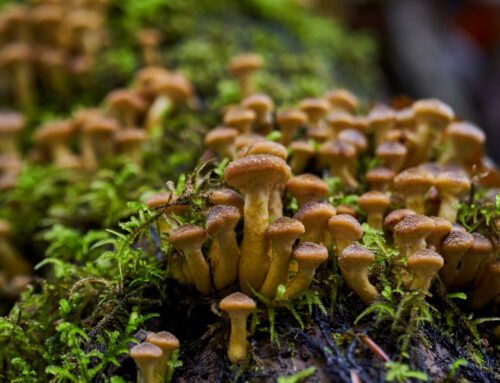Use case: Glyphosate.
Have you ever heard of Agent Orange, massively sprayed by the US air force during the Vietnam War?
It was one of the so-called “Rainbow Herbicides” – total herbicides and defoliants, intended to kill every green plant and cause every leaf to fall off 1. The idea was to devastate Vietnamese food production and also, to prevent Vietnamese soldiers of hiding in the jungle. Consequences of application of highly toxic Rainbow Herbicides were fatal: estimated 400 thousand Vietnamese and 300 thousand US soldiers were killed or permanently disabled and 4.8 million people affected by cancers, birth defects, neurological, immune and other health disorders 2,3.
Nonetheless, interest in development of new generations of herbicides was high. In early 1970s, Monsanto Company, one of the main producers of Agent Orange, patented new, broad-spectrum herbicide Glyphosate, later also known by its commercial name “Roundup” 4. In the 1990s, new technology based on genetically modified (GM) crops tolerant to Glyphosate (Roundup) appeared. By spraying fields with Roundup, all plants but the GM die. This is why Monsanto´s new GM seed brand was named “Roundup Ready”.
Continuing tradition from the Vietnam war, between 2000-2015, as a part of the plan of the US government to eradicate drug production in South America (Plan Columbia), Glyphosate was deliberately sprayed to destroy coca fields. In 2015, as the World Health Organization (WHO) reported Glyphosate as probably carcinogenic, Columbian operations were shortly stopped to be resumed again in 2016 4–6. Glyphosate is currently the most applied herbicide worldwide, known by many other commercial names and massively used on GM and non-GM crops, in orchards, parks, rivers etc. 4,7,8. Global Glyphosate market is expected to reach $34.01 billion in 2022 9.
What are the effects of Glyphosate on the environment, humans and microbiomes?
Glyphosate has been repeatedly claimed by its producers and supporters as harmless for all living organisms except weeds. However, many studies have shown its accumulation in soil, freshwaters, plant products, animals and humans 8.
Besides the above-mentioned WHO reports about probable carcinogenicity 10, in 2019 Monsanto was ordered by US court to pay $289 million to an American farmer who contracted cancer from Roundup 11. Unusually high number of miscarriages and respiratory illnesses have been reported in the sprayed areas in Columbia and links have been found between Glyphosate usage, infertility, kidney damage and neurological conditions such as ADHD, autism, Alzheimer’s and Parkinson’s disease. Similar damages have been observed in experiments with human cell lines and in animal models (mice, rats, pigs…). Embryonal development is especially badly affected in frogs (tadpoles) treated with Roundup 4,8.
Although animals do not have the same enzymatic pathway attacked by the Glyphosate as plants, many microorganisms do. As a consequence, soil microbiomes are disturbed, in particular the important nitrogen-fixing bacteria. In waters, green microalgae, the crucial producers in the food chain are badly hit and the beneficial bacteria in animal microbiomes seem to be more susceptible to Glyphosate than the pathogenic ones 8. Recent studies in humans suggest the same: after Glyphosate exposure there is an overgrowth of harmful-metabolite-producing bacteria potentially affecting the brain 12. By the way, due to the massive Glyphosate use, many weeds have already gained natural resistance.
How can we use microbes to degrade Glyphosate?
Glyphosate can be physically degraded by temperature or light. However, in nature, except in sewage plants, these methods are usually not feasible. Therefore, microbial degradation is a promising option for bioremediation of Glyphosate as well as of other pesticides.
Researchers have already identified around 20 bacterial and 5 fungal strains with the ability to degrade Glyphosate. Unfortunately, their potential for bioremediation of Glyphosate in soil has been studied so far only in few bacteria and only under laboratory conditions. For drinking water, absorption of the pesticide is an additional step required before microbial degradation.
Second, two major enzymatic pathways for Glyphosate degradation are already known. However, problem is that some of the intermediary metabolites of Glyphosate degradation (as well as of other pesticides) are also toxic and ideally should be removed completely from the environment. To achieve this, better understanding of all genes and enzymes involved is required.
Also, for successful pesticide bioremediation, single, free-living microorganisms will most likely not work in the natural setting. Precisely defining “teams” of microbes, so-called “microbial consortia” will be probably needed.
Finally, in all of the above, “omics” technologies could be helpful. For example, metatranscriptomic approaches could identify highly expressed genes of interest. Metagenomics could identify microbial strains required for the consortia and metabolomics would identify metabolites produced by the community which, for example, could boost expression of the target genes 9,13,14.
And not only for Glyphosate, but many other pesticides and environmental contaminants…
– Follow us next week, when we will discuss bioremediation of heavy metals…
Literature:
- Agent Orange. Wikipedia.
- Write, Laura. New Study Finds Agent Orange Use Was Underestimated. Scientific American (2003).
- Staff, I. of M. Veterans and Agent Orange: Health Effects of Herbicides Used in Vietnam. (National Academies Press, 1994).
- Szekacs, A. & Darvas, B. Forty Years with Glyphosate. in Herbicides – Properties, Synthesis and Control of Weeds (ed. Hasaneen, M. N.) (InTech, 2012). doi:10.5772/32491.
- Colombia to use glyphosate in cocaine fight again. The Guardian (2016).
- Restarting Aerial Fumigation of Drug Crops in Colombia is a Mistake. (2019).
- Myers, J. P. et al. Concerns over use of glyphosate-based herbicides and risks associated with exposures: a consensus statement. Environ Health 15, 19 (2016).
- Van Bruggen, A. H. C. et al. Environmental and health effects of the herbicide glyphosate. Science of The Total Environment 616–617, 255–268 (2018).
- Singh, S. et al. Herbicide Glyphosate: Toxicity and Microbial Degradation. IJERPH 17, 7519 (2020).
- Guyton, K. Z. et al. Carcinogenicity of tetrachlorvinphos, parathion, malathion, diazinon, and glyphosate. The Lancet Oncology 16, 490–491 (2015).
- Monsanto ordered to pay $289 million in roundup cancer trial. New York Times (2018).
- Rueda-Ruzafa, L., Cruz, F., Roman, P. & Cardona, D. Gut microbiota and neurological effects of glyphosate. NeuroToxicology 75, 1–8 (2019).
- Zhan, H., Feng, Y., Fan, X. & Chen, S. Recent advances in glyphosate biodegradation. Appl Microbiol Biotechnol 102, 5033–5043 (2018).
- Pileggi, M., Pileggi, S. A. V. & Sadowsky, M. J. Herbicide bioremediation: from strains to bacterial communities. Heliyon 6, e05767 (2020).





